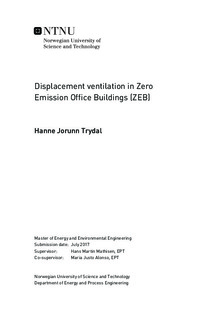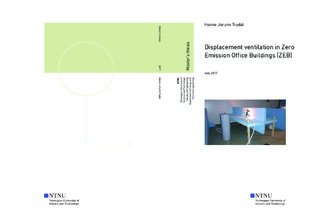| dc.description.abstract | This thesis investigates the ventilation efficiency and thermal climate of Powerhouse Kjørbo, located in Sandvika, Norway. Powerhouse Kjørbo consists of two buildings in a building complex of nine buildings, where building 4 and 5 have been renovated to zero-emission office buildings. They were renovated from conventional office buildings to plus houses, producing more energy than they consume in their operational lifetime, minus the equipment load. Building 4 is further investigated in this thesis. The ventilation principle used is displacement ventilation, supplied by few large diffusers in a large open office landscape. Several previous studies have examined the indoor climate of Powerhouse Kjørbo. Tracer gas measurements have shown the ventilation efficiency was lower than expected, looking more like mixing ventilation than displacement ventilation. CO2 concentration measurements showed the overall air quality was good. However, concentration measurements from the east corner suggest this location as a stagnant zone, as the concentration was equal in height, and higher than the exhaust concentration. The east corner is almost completely enclosed by bookshelves placed directly on the floor. This can hinder the displacement supply flow significantly.
A scaled model has been built of half the 2nd floor of Powerhouse Kjørbo, to investigate ventilation efficiency and temperature distribution. Air velocity measurements have been performed on a supply diffuser, mapping the supply air velocities. Smoke experiments have been conducted at several locations in the model, to get a better overview of the air flow patterns. Temperature and tracer gas measurements have been conducted simultaneously for three different experimental cases, where the internal heat loads were changed. The temperature distribution and ventilation efficiency for different conditions were measured. The results have been compared to values from the prototype when available.
The velocity of a supply diffusers in the model was mapped. The results were compared to measurements from the corresponding supply diffuser in the prototype. The velocity mapping show the air distribution in the model and prototype differ. The model results show the negative buoyant effect expected for displacement ventilation. The prototype results indicate the supply air may be too warm. Smoke visualization of the air flow patterns in the model generally show the air behaves as for displacement ventilation. Some smoke experiments show the air flow patterns are unstable. The east corner gets a notably smaller supply air flow at floor level, compared to the south corner. This is confirmed by the tracer gas measurements.
The local air change index in the east corner is 95 %-units to 159 %-units smaller than the south corner, depending on the internal heat gain and local presence. However, both the east and south corner measurements show values consistent with good displacement ventilation. The minimum measurement at floor level was 161 %-units (East 25, Case II). The local air change efficiency increased with an increased presence. The east corner was almost completely enclosed by two large bookshelves. To see if the local air change index increased with a smaller bookshelf, the one facing north was halved in size. The tracer gas experiments showed a small increase in the local air change index (13 %-units at 25mm height), though the uncertainty of the measurements are large. The mean air change efficiency was higher than 64 %-units for the three different experimental cases, and higher than 60%-units for all measurements, indicating the model has good displacement ventilation.
Temperature measurements show the east corner had a higher temperature compared to other parts of the open office landscape. The temperature gradient in the east corner was however lower than in the south corner. This indicate that less air enters the east corner, which has also been seen from the smoke visualization and tracer gas measurements. The temperatures increase with a higher occupancy, as does the temperature gradients. However, scaled to full size, the temperature gradients are well within the maximum recommended vertical temperature difference.
The model and prototype results does not correspond. The model show results for good displacement ventilation, while the prototype indicate mixing ventilation and stagnant zones. The differing results does not mean that model similarity has not been reached, but indicate the prototype has a possibility of achieving good displacement ventilation. However, as the model has not been validated, that could not be determined for certain. The main reason for the differing results in the model and prototype have been identified as the different supply temperatures. The understanding of results are still valuable, since they demonstrate measurements for a smaller building, similar to the prototype. | |

